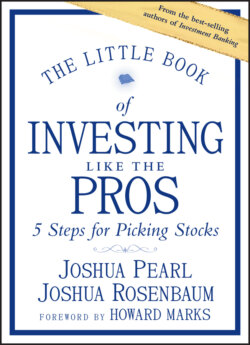Читать книгу The Little Book of Investing Like the Pros - Joshua Rosenbaum - Страница 17
5-Step Framework
Оглавление1 Idea Generation
2 Identifying the Best Ideas
3 Business & Financial Due Diligence
4 Valuation & Catalysts
5 Investment Decision & Portfolio Management
Our flagship case study centers on Delphi Automotive, a global automotive supplier that was the predecessor company to what are now two distinct entities following a tax-free spin in December 2017.2 Today, these entities trade independently as Aptiv (APTV) and Delphi Technologies (DLPH).
Throughout the book, we focus on the opportunity that investors faced upon Delphi Automotive's initial public offering (IPO) in November 2011. By the time of the company's split in 2017, those who invested from the beginning made nearly five times their money. Using our framework, we take you back in time to illustratively guide you through the process that helped discover, analyze, value, and bless this stock.
Delphi was a textbook restructuring and turnaround opportunity. Before filing for bankruptcy in 2005, it had a fragmented business model with an uncompetitive cost structure and burdensome liabilities. Delphi used the bankruptcy process to rationalize its product lines, sell uncompetitive businesses, and migrate manufacturing to best-cost countries (BCCs). Delphi's lead shareholders, Silver Point Capital and Elliott Management, played a key role in the turnaround, working with CEO Rod O'Neal and the management team to transform the company. The reconfigured strategy for the “New Delphi” centered on technology and the three core themes of “Safe, Green and Connected.”
Upon emergence, Delphi featured a focused product portfolio, globally cost-competitive structure, and revamped balance sheet. The company also had a concentrated shareholder base that was very active in pursuing value creation. Over time, these core shareholders would be natural sellers as Delphi's stock performed.
As part of their value creation plan, the lead shareholders assembled a world-class Board of Directors, comprised of public company CEOs, auto industry veterans, and highly experienced domain experts (e.g., technology, human resources, capital markets, and M&A). Former DuPont Chairman and CEO Jack Krol was appointed Chairman of the Board and played a critical role. His background as lead director of Tyco International, where he oversaw their successful corporate overhaul, was a key factor in the lead shareholders' decision to bring him on board. He and his fellow directors were instrumental in working with management to develop the strategy around capital allocation, IPO preparation, and messaging to investors.
Delphi also emerged with a more competitive tax regime at the time due to its status as a U.K. tax payer. Add in secular and cyclical tailwinds, a fortified moat, improved financials, and a compelling valuation—in sum, there were multiple ways for an investor to win. There were also many risks to consider. You just had to know what to look for … and how to do the work.
In late 2011, Delphi went public at a $22 share price. The new strategy would prove enduring over the next several years, persisting long after O'Neal passed the reins to CFO Kevin Clark in 2015. Along the way, there were numerous strategic initiatives that created significant value for shareholders, culminating with the tax-free spin of Delphi's Powertrain Systems segment in 2017.
By the end of 2017, just prior to Delphi's separation into two entities, the stock was trading above $100 per share. Investors who seized upon the opportunity at Delphi's IPO were rewarded with a 375% return. This represented a 30% annualized return vs. the S&P 500 at 13%.
Our 5-step approach to stock picking is designed to help you uncover the next Delphi Automotive. It is also designed to help you manage your stock positions along the way. For example, in 2018, the automotive market began to show signs of a cyclical slowdown. As discussed in the Post-Mortem, the newly spun powertrain business, Delphi Technologies, also experienced some self-inflicted wounds and headwinds related to its geographic footprint. Our system of early warning signals and active monitoring is crafted to help you avoid these pitfalls. Knowing when to exit or downsize a position is no less important than determining when to enter or upsize.
